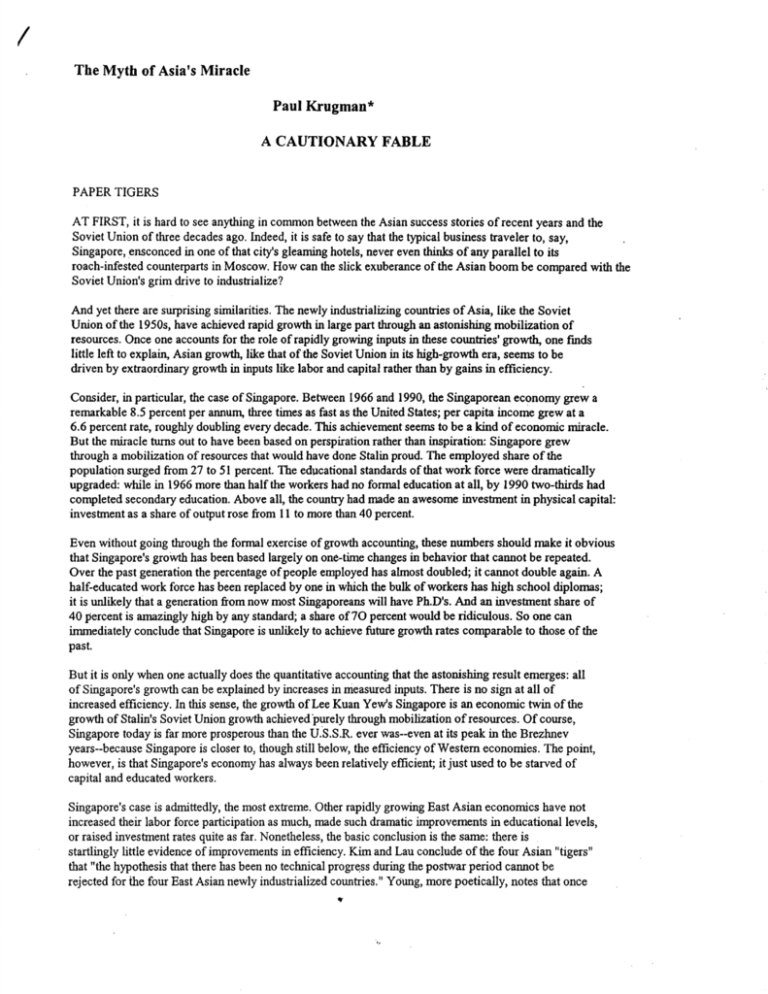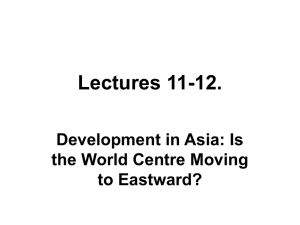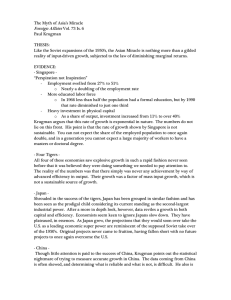The Myth of Asia's Miracle Paul Krugman* A
advertisement

/
The Myth of Asia's Miracle
Paul Krugman*
A CAUTIONARY FABLE
PAPER TIGERS
AT FIRST, it is hard to see anything in common between the Asian success stories of recent years and the
Soviet Union of three decades ago. Indeed, it is safe to say that the typical business traveler to, say,
Singapore, ,ensconced in one of that city's gleaming hotels, never even thinks of any parallel to its
roach-infested counterparts in Moscow. How can the slick exuberance of the Asian boom be compared with the
Soviet Union's grim drive to industrialize?
And yet there are surprising similarities. The newly industrializing countries of Asia, like the Soviet
Union of the 1950s, have achieved rapid growth in large part through an astonishing mobilization of
resources. Once one accounts for the role of rapidly growing inputs in these countries' growth, one fmds
little left to explain, Asian growth, like that of the Soviet Union in its high-growth era, seems to be
driven by extraordinary growth in inputs like labor and capital rather than by gains in efficiency.
Consider, in particular, the case of Singapore. Between 1966 and 1990, the Singaporean economy grew a
remarkable 8.5 percent per annum, three times as fast as the United States; per capita income grew at a
6.6 percent rate, roughly doubling every decade. This achievement seems to be a kind of economic miracle.
But the miracle turns out to have been based on perspiration rather than inspiration: Singapore grew
through a mobilization of resources that would have done Stalin proud. The employed share of the
populatiQn surged from 27 to 51 percent. The educational standards of that work force were dramatically
upgraded: while in 1966 more than half the workers had no fonnal education at all, by 1990 two-thirds had
completed secondary education. Above all, the country had made an awesome investn'ient in physical capital:
investment as a share of output rose from 11 to more than 40 percent.
Even without going through the fonnal exercise of growth accounting, these numbers should make it obvious
that Singapore's groWth has been based largely on one-time changes in behavior that cannot be repeated.
Over the past generation the percentage of people employed has almost doubled; it calUlot double again. A
half-educated work force has been replaced by one in which the bulk of workers has high school diplomas;
it is unlikely that a generation from now most Singaporeans will have Ph.D's. And an investment share of
40 percent is amazingly high by any standard; a share of70 percent would be ridiculous. So one can
innnediately conclude that Singapore is unlikely to achieve future growth rates comparable to those of the
past.
But it is only when one actually does the quantitative accounting that the astonishing result emerges: all
of Singapore's growth can be explained by increases in measured inputs. There is no sign at all of
increased efficiency. In this sense, the growth of Lee Kuan Yew's Singapore is an economic twin of the
growth of Stalin's Soviet Union growth achieved 'purely through mobilization of resources. Of course,
Singapore today is far more prosperous than the U."S.S.R. ever was--even at its peak in the Brezlmev
years--because Singapore is closer to, though still below, the efficiency of Westem economies. The point,
however, is that Singapore's economy has always been relatively efficient; it just used to be starved of
capital and educated workers.
Singapore's case is admittedly, the most extreme. Other rapidly growing East Asian economics have not
increased their labor force participation as much, made such dramatic improvements in educational levels,
or raised investment rates quite as far. Nonetheless, the basic conclusion is the same: there is
startlingly little evidence of improvements in efficiency. Kim and Lau conclude of the four Asian "tigers"
that "the hypothesis that there has been no technical progr~ss during the postwar period cannot be
rejected for the four East Asian newly industrialized countries." Y bung, more poetically, notes that once
.•..
one allows for their rapid growth of inputs, the productivity perfonnance of the "Tigers" falls "from the
heights of Olympus to the plains of Thessaly.
This conclusion runs so counter to conventional wisdom that it is extremely difficult for the economists
who have reached it to get a hearing. As early as 1982 a Harvard graduate student, Yuan Tsao.) found
little evidence of efficiency growth in her dissertation on Singapore, but her work was, as Young puts it,
"ignored or dismissed as unbelievable." When Kim and Lau presented their work at a 1992 conference in
Taipei, it received a more respectful hearing, but had little immediate impact But when Young tried to
make the case for input-driven Asian growth at the 1993 meetings of the European Economic Association, he
was met with a stone wall of disbelief.
In Young's most recent paper there is an evident tone of exasperation with this insistence on clinging to
the conventional wisdom in the teeth of the evidence. He titles the paper "The Tyranny of Numbers"--by
which he means that you may not want to believe this, buster, but there's just no way around the data. He
begins with an ironic introduction, written in a deadpan, Sergeant Friday, "Just the facts, ma'am" style:
"This is a fairly boring and tedious paper, and is intentionally so. This paper provides no new
interpretations of the East Asian experience to interest the historian, derives no new theoretical
implications of the forces behind the East Asian growth process to motivate the theorist, and draws no new
policy implications from the subtleties of East Asian government intervention to excite the policy
activist. Instead, this paper concentrates its energies on providing a careful analysis of the historical
patterns of output growth, factor accumulation, and productivity growth in the newly industrializing
countries of East Asia. It
Of course, he is being disingenuous. His conclusion undennines most of the conventional wisdom about the
future role of Asian nations in the world economy and, as a consequence, in international politics. But
readers will have noticed that the statistical analysis that puts such a different interpretation on Asian
growth focuses on the "tigers," the relatively small countries to whom the name .tnewly industrializing
countries" was frrst applied. But what about the large countries? What about Japan and China?
Sound Finance and Sustainable Development in Asia
Keynote Address to the Asia Development Forum
by
Joseph Stiglitz
Senior Vice President and Chief Economist
The World Bank
Manila, the Philippines, March 12, 1998
The Allocation of Investment and Productivity Growth
Although in traditional neoclassical economic model, investment and saving are detennined independently, most
empirical research has found that
most of an increase to saving gets translated into higher investment. East Asia is no different, and its high saving
rates have been essential to
maintaining its high rate of capital accumulation, contributing strongly to its growth.
Research by Alwyn Young, long II Kim and Lawrence Lau, and popularized by Paul Krugman, has argued that
rapid capital accumulation is
"actually all there is to the East Asian miracle. According to their estimates, total factor productivity growth, the
additional output that cannot be
explained by increases in capital or labor, ranged from unremarkable in Korea to virtually nil in Singapore. In
interpreting their results, however, it
is important to note that even in the extreme, and in my view, unlikely event that East Asia had no total factor
....
productivity growth, the region still
would have demonstrated a remarkable ability both to maintain high saving rates and to allocate that capital to
productive uses.
This latter point is particularly underappreciated. An aggregate production function is second nature to many of
us trained in economics. Greater
capital, all else being equal, will shift an economy along its production function, increasing output, albeit with
diminishing returns. In reality,
however, all else is not equal. In a world of perfect information, additional financing will go to the projects with
the highest rates of return. In a
world of imperfect infonnation, incomplete risk markets, and transaction costs, however, the translation of saving
into the best investment prospect
is not automatic. The process of investing a large fraction of GOP can result in large costs of adjustment and
misallocated investment. Indeed, we
have seen many examples of countries that have had high rates of investment and negative total factor
productivity growth. The fact that, even
according to the most critical view, East Asia has managed to move along an ~changed production function is an
accomplishment.
/
I do not believe, however, that East Asia has grown through investment alone. Any visitor to the cities and
factories in East Asia comes away
impressed by the enonnous technological progress in the last decades. The Young, Kim, Lau, et al. results. are
simply not very robust. When a
COWltry is accumulating capital rapidly, small changes in the estimate of the capital share can result in a large shift
in estimates of the contribution of
total factor productivity. Estimating these shares is very problematic, especially in East Asia where the
assumption ofperfect competition in labor
and product markets is inappropriate, at least in some economies. There are also problems in the measurement of
human and physical capital.
Moreover, we must remember that technology is both the cause and the consequence of investment. Without
improving technology, diminishing
.
returns would have set in, and it is hard to believe that investment could have been sustained. These
considerations make me reasonably confident
that East Asia has seen impressive productivity growth in recent decades.
East Asia's productivity growth is the result of many factors, including an emphasis on factor accumulation, both
of physical and human capital. But
other policies have mattered as well, such as the promotion of social inclusion and the transfer of teclmology.
These have been extensively
analyzed in the World Bank's East Asian Miracle study and in a huge literature in recent years. Today, I would
like to concentrate on the
contribution of the fmancial system to growth. In the next section I will discuss general theoretical and empirical
evidence on the relationship
between finance and growth, introducing some concepts that I will return to in later parts of the lecture.
EM~1\~~~l
ON
----
oe
'~60-2.000
CO \J NR' ES'
C\)
\f\ (]
L~
~ l
·
/+o\JJ l \\ (
Ii G(~. 0/\1
£:' t~~ lu ~ ~.
~f1iML ~ee~ II
o&A
us
O'go
\
1\
-13+~
1\
.-3)
0
}
ir
i
/~ '9Y
'''to urt,
'"
\t!l0LE -;c
N
9
"
l~~
~ K C Pc~(O\)~
G t» NU M. 't
O\J\Qu\
E,
r
,o~
A
~
~~
L----.. .- --J
~
o~go
~ -0
~-JI
/\
/'\
\3
~
~
otA
l~
fGJ
L--J
o,s-B
l
OIV~
AJ \14 AJ bf\ OUj1rt+
1~() ~
li0NG k O/J(O
t
p~(J
11
l.~
l '9 b 6- (~~ J
Iv-~
/'\.
4- 0'6e =- l{ I (Jap)
'l
~.~
VvelG~,
/'\..
l
n
p
~
'(
~
O,o~l
0, O()~
U1.&J1L
r'-l:~~:~
~ tt~_
l--oL
Ot S0 9
6~ou..;"n\
~
LM ~ J<..
O\J\'P\JT
.A
c.~o ;~l
/\
/'\
"I
~
L
Ot S-,l
9'10
ttv,
o t\~O
O\b? ~
~oA.il7\ '\ ~ u h'0 A.J
O~
C:.l~prML
.r~~\7
~01
r.s
~-ol)L
O,~
/\
~
~
~1"
-:zr
T
OJ4
O,,{'1
O,?>9
L-
14~ \>5
t-()
::: 0,
S"ll - t?,~93)(O,(O~~ -(I--D,3.n) 0,/3 0
c..
J
( J
o ' "2- 1
~ 0 ( 0 '"T<?~----/
Oi
2-2.-
t
//1.
,I'
l/
/
.I
,/
/0
'-''/-10
~oC-OUJ
.....
~
\'tH
-
N..ot)et
H-\JM.A~
t, '=
c:...A~t'~ ~
S \(lll
(eve L
~s P&"~
1\
~':'1
Q-J
A
ON
~. ~tO~N\
I
)L:.'-\
if ~ ~ 't..... s ~
AtVALtc~ \t1\J f'U:)tec...
C£> tool( 1f-\ ~c; ~
't
(%)
e-t>u ~ 'h'o-v)
C.OM.P, ~n'~).
==:>
~~, \
~
:Il
~
--k
'(
_
r
UJ
=:9
'/
-
A.l
-.::1_____
A. ~.~
K 0\)" fit a'e'!>
~ y r~",,- ~ a' L l
~~ ,iv
1I14-'l(~"'~le'.r:
-C (...14 ,'t1. ,
"
I(-
~L.
1\.0 bi ~a' ~ ~
...............~------.....
I4'-lL
S 'f r~~
~
"I
'­
~ Jell ~ t, l ) l-oL
~ iv, ~~tW.r rl)E"r ~ y
'I
__
AI­
-
~"L
k
~
tJ'1 t, L).t
J •••• ~ o~
---"} .......
0)
rJJ '(
Jr
-:.
.....
....
~
~
-.~
y /1+1, L
k /4"eL.
~
.)-\
A\
..
~
..
-
~
-:..
($+3 . . \tJ
_ __ (Jt-,+,)
~ 6'
---~/-
tQ~Pu~
lAJ t<..(
,
A-,...
4
.s', S\-,\
U of t'~ ~
r ~ tQ,(J~M~"
~
s. .r.
'I
\ 'Q.
~
"l
A-,..
::.0
(t
4) .'
~
.A
=-0::
~
~~ -A
~ -l--/ ..... (.c:...1-1
~\
~-I-')I
fJ.J -'\
ot-I
.;:
__
-.
S+~~'1
~ ~ t....(
~
-l-.L
i
~-+l'"
~ ~ 41(--'
-------==~:--------.
---.".as
~~
~
~:
~If,"')~
~"
~----- ~J\
--7~
Co AJ
(.
c. uti' 0 AI 1
~AJe~ Q~
\!!J
~ ~LLO\.UI~_~
~ ~~
......, A£.O-u CCa
.q ~ ~ ~ ,-+~
A
A
~:::L.
0'--\ O\l't"'
\4.10 t\ Ie
e:'\.
0 "
~d
(Jel'\
CQK- ~~ f
Ao-\ '" A~ 't)FL ~l~ •
< (~A.lG~
L~fIe L Q~
1>e-fe'AI~r
fA- TTl
(:) ~
C'-'\'~
~'\. \J-..)~I\k~~
QA.I
Cftcte(..A ~o '\ t-o~c...c
ltuKIrN
S Ie. tL L
I
(. eve (..
'5C€~
0~
cA" l~ L .
tL"'" QAJ ~ ~ 9 '\. ~t.J.;..<';:.;;:Q~ .........__
- 't>,<.\
..(~~e;c.;~er.r
~~~QJ'.r
c...ocJ~, E r.
-
Ac.oAJG
~ c;t. ~e- (J;:)t'\ PA\. ~
'L
~~
~
CoUNII\ \"e-
s
.,.
'l,~
~t t. -
-
~ \ J l. ~J..
( .!l,
)f~1
\@.+~,
~,
A
C£~~~,,:j\ "L ·A~~
--b-­
~
~\t-
.....
•
/21,
S
"',
\-.&.,
~2I ;; aI'..J.\,
~
d ~'(;
~1-
,
~~
ttteA.t
~
\
~lt
~,,~
wf:k~ "", LL
~U€Sh"O ~ :
. Al t:
-.
\'-
~
"It­
~ \t.
'G f... ~
~N
we
<;eAle-",,, l
,q.1J'\') ~ ~
~\
~'1 1$ ..r,...~~
A-t.'tor s c-o u AJ"''lt~s _
l:fI=
lS 1l\e JA"-t: ~ ~
8
eve'N
k~<'
~Q\JI'.J\'\."'~f
O~
~
I
L~ '-'6
L
~ 4'Ar~ A-\ ~p wllL
1¢ e ~
l:~~ t2J' S ~'\ e
YJrWt) ~e:L,' SAlle- 1)\ P-f'e'( ec..,-r
='
b'\~~ ~
(\ e<; A '\'> tAl E.
"o~ec...
~M..'( ,toe-,
ec.'.'( \
~ ~ '\'E. S ~
~,-
c.~vNl\I~~J
~\L L
e,r.,.,c.e t+; ca ~ 'L G 1) f .-~
(01\ oUJ1r\- t 11te
~I\ twe'l ~~'ou.....
~y
~~
'4 ~ ~
we
~,+~
~"tQ~ ~il\.
~~".
o~s-e,\ve 1\\t~ IN Ttte
'JJ e
nq.~
1ttt\\"
\\
c..o~1) t 11 QlvA~
-7'"
C,..c)~ve'l_
,
e.u c::.'t
No c. '0 r.
(I
F=v~\OAf ~"
,
"'1-\.O\J
w,.
Q~
1'\"M. e- .s ~~l
.. Acc..vt\.U'A'\\NG.
.s tct(.,lS
...
~
~~~.~
o~
~ ~ t\.\lc.H
Pea' (.,e
~,-
"'11 ~
f+~ve fP~'-'
..r c..Ha~ <-.







